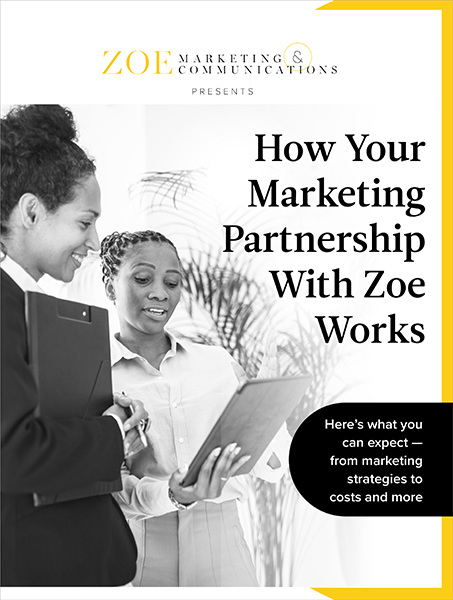
Download Your Guide to Marketing With Zoe
From the first steps and your role in success to specific services, pricing and success stories, learn all about partnering with Zoe.
January 17th, 2023 | 2 min. read
By Kim Kovelle

We don’t spend all our digital time in one spot. We bounce from email to social media to Google to YouTube. That’s why 54% of marketers use 3-4 methods to reach prospects, according to PFL’s latest State of Multichannel Marketing report.
It makes sense: More marketing = more people. But if you’re a small- to mid-size business with a limited budget, making the shift to multichannel marketing can feel overwhelming.
At Zoe Marketing & Communications, we’ve helped businesses build layered marketing strategies since 2020. Here’s why a multichannel approach is worth it.
From the first steps and your role in success to specific services, pricing and success stories, learn all about partnering with Zoe.
Your audience is everywhere. If you’re using just one or two tactics, you’re likely missing potential customers.
For example, maybe your Meta (Facebook and Instagram) ads are performing well. But programmatic or retargeting ads could tap into a new audience segment.
Each platform allows different targeting criteria — such as behavior, interests and past site visits. The key is testing and tracking to see where your audience engages most.
Plus, timing matters. Someone scrolling social media might not be in the mindset to act, but they might be when searching Google.
People go through three stages when considering your business:
Layered marketing keeps you in front of prospects at every stage. The same tactics work differently at each point:
Showing up in multiple places makes you more recognizable and builds credibility. This strengthens three areas:
No single tactic does it all. Each brings a unique strength:
A mix ensures you cover all bases.
Layering tactics keeps prospects engaged across different platforms. This builds:
Keeping branding and messaging consistent across channels strengthens results.
A multichannel approach makes your marketing more efficient and cost-effective:
Multichannel marketing is essential for sustainable business growth. This approach helps you reach more high-quality prospects at different buying stages while optimizing your efforts.
If you’re ready to explore a layered marketing approach, talk to us at Zoe Marketing & Communications. We’ll create a strategy that maximizes your marketing impact.
Still considering your options? Continue learning:

From the first steps and your role in success to specific services, pricing and success stories, learn all about partnering with Zoe.
As Zoe Marketing & Communications’ content manager, Kim Kovelle brings over 20 years of writing and editing experience in metro Detroit. She has strong roots in community journalism and a knack for making complicated topics make more sense.
